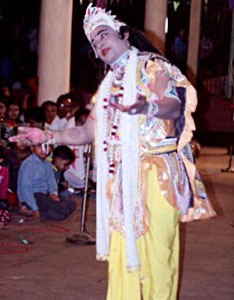 The drama Rukmini-harana is acquired from Harivamsam and Bhagavata Purana. It has its storyline based on love and union, blood and conflict. Rukmini, the daughter of King Bhismaka of Kundina falls in love with Lord Krishna as a result of the two coming to know about each other`s undertakings through the narration of two bhatas, Suravi and Haridasa by name. Both were deeply in love with each other but Rukma, Rukmini`s brother were against their relationship. He chooses a prince Sisupala for his sister. The marriage was arranged and Prince Sisupala with his associates came to Kundina for marriage. Rukmini on the other side extremely worried and terrified sent her message to Krishna through Vedanidhi, the royal priest acting as messenger. Krishna on obtaining Rukmini`s letter started off instantly from Dwaraka to Kundina. On the other side princes from different territories began gathering for the wedding ceremony. Rukmini after offering obeisance at the Bhavani temple appeared before the guests. To utter dismay of Sisupala, Krishna had arrived and eloped with Rukmini in his chariot.
The drama Rukmini-harana is acquired from Harivamsam and Bhagavata Purana. It has its storyline based on love and union, blood and conflict. Rukmini, the daughter of King Bhismaka of Kundina falls in love with Lord Krishna as a result of the two coming to know about each other`s undertakings through the narration of two bhatas, Suravi and Haridasa by name. Both were deeply in love with each other but Rukma, Rukmini`s brother were against their relationship. He chooses a prince Sisupala for his sister. The marriage was arranged and Prince Sisupala with his associates came to Kundina for marriage. Rukmini on the other side extremely worried and terrified sent her message to Krishna through Vedanidhi, the royal priest acting as messenger. Krishna on obtaining Rukmini`s letter started off instantly from Dwaraka to Kundina. On the other side princes from different territories began gathering for the wedding ceremony. Rukmini after offering obeisance at the Bhavani temple appeared before the guests. To utter dismay of Sisupala, Krishna had arrived and eloped with Rukmini in his chariot.
This drama is noted for its attempts to depict the love of Krishna for his devotees and his competence is also rightly justified in the play. On being deceived Sisupala and Rukma along with other princes call for a battle with Krishna. Krishna proves his prowess and wins over them. On Rukmini`s appeal Krishna pardons her brother Rukma. Krishna and Rukmini were finally married at Dwaraka. Here in the play the character of Rukmini is well portrayed as a woman in divine love with her lover. Being the central character of the play Rukmini is projected as a woman with intense dignity, wise with unfathomable love and adornment for her lover. The other characters are also portrayed with sympathy and insight. Sankardeva possibly portrayed these scenes in order to create an atmosphere of popular appeal.
This article is a stub. You can enrich by adding more information to it. Send your Write Up to content@indianetzone.com













